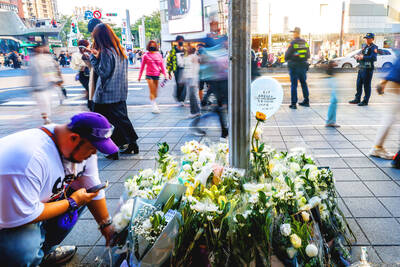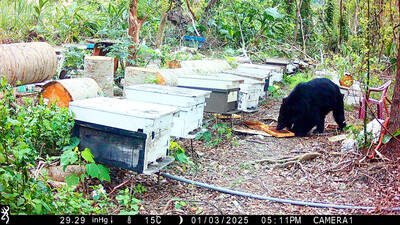Seven more foreign news outlets have applied to open bureaus in Taiwan this year, including the New York Times, the Ministry of Foreign Affairs said on Friday, following China’s expulsion of US journalists in March.
After the US placed a personnel cap on four Chinese media companies, China responded by banning US reporters for the New York Times, the Washington Post and the Wall Street Journal from covering news from China, Hong Kong and Macau.
“We maintain bureaus in Beijing and Shanghai with correspondents, and are hopeful that the Chinese government will allow all of our reporters to return,” New York Times spokeswoman Danielle Rhoades Ha said in an e-mail to the Taipei Times.
“As a result of the expulsion order, some affected correspondents are in the process of relocating to Taipei and Seoul. Our newsroom has not missed a beat and continues to cover China fairly and aggressively,” she said.
“It’s great having @nytimes reporters in #Taiwan. Our vibrant international media landscape is much the richer for their presence,” Minister of Foreign Affairs Joseph Wu (吳釗燮) wrote on Twitter on Friday. “Welcome & enjoy the country’s freedom in producing all the news that’s fit to print!”
Ministry spokeswoman Joanne Ou (歐江安) said that the ministry has also welcomed the Washington Post and the Wall Street Journal to establish branches in Taiwan, although they have not formally submitted requests.
Including the new applications, 59 foreign news outlets are stationed in Taiwan from 16 nations: France, Germany, Indonesia, Japan, Malaysia, the Netherlands, Norway, the Philippines, Singapore, Slovakia, South Korea, Spain, Sweden, Switzerland, the UK and the US, she said.
The number of foreign journalists in Taiwan has increased in the past few years, as the nation’s press freedom has been praised by the global community, she added.
Before the nation’s presidential and legislative elections on Jan. 11, more than 210 foreign journalists, including nearly 60 originally stationed in Taiwan, had applied for permits to cover the elections, the ministry said.

SHIPS, TRAINS AND AUTOMOBILES: The ministry has announced changes to varied transportation industries taking effect soon, with a number of effects for passengers Beginning next month, the post office is canceling signature upon delivery and written inquiry services for international registered small packets in accordance with the new policy of the Universal Postal Union, the Ministry of Transportation and Communications said yesterday. The new policy does not apply to packets that are to be delivered to China, the ministry said. Senders of international registered small packets would receive a NT$10 rebate on postage if the packets are sent from Jan. 1 to March 31, it added. The ministry said that three other policies are also scheduled to take effect next month. International cruise ship operators

HORROR STORIES: One victim recounted not realizing they had been stabbed and seeing people bleeding, while another recalled breaking down in tears after fleeing A man on Friday died after he tried to fight the knife-wielding suspect who went on a stabbing spree near two of Taipei’s busiest metro stations, Taipei Mayor Chiang Wan-an (蔣萬安) said. The 57-year-old man, identified by his family name, Yu (余), encountered the suspect at Exit M7 of Taipei Main Station and immediately tried to stop him, but was fatally wounded and later died, Chiang said, calling the incident “heartbreaking.” Yu’s family would receive at least NT$5 million (US$158,584) in compensation through the Taipei Rapid Transit Corp’s (TRTC) insurance coverage, he said after convening an emergency security response meeting yesterday morning. National

PLANNED: The suspect visited the crime scene before the killings, seeking information on how to access the roof, and had extensively researched a 2014 stabbing incident The suspect in a stabbing attack that killed three people and injured 11 in Taipei on Friday had planned the assault and set fires at other locations earlier in the day, law enforcement officials said yesterday. National Police Agency (NPA) Director-General Chang Jung-hsin (張榮興) said the suspect, a 27-year-old man named Chang Wen (張文), began the attacks at 3:40pm, first setting off smoke bombs on a road, damaging cars and motorbikes. Earlier, Chang Wen set fire to a rental room where he was staying on Gongyuan Road in Zhongzheng District (中正), Chang Jung-hsin said. The suspect later threw smoke grenades near two exits

The Forestry and Nature Conservation Agency yesterday launched a gift box to market honey “certified by a Formosan black bear” in appreciation of a beekeeper’s amicable interaction with a honey-thieving bear. Beekeeper Chih Ming-chen (池明鎮) in January inspected his bee farm in Hualien County’s Jhuosi Township (卓溪) and found that more than 20 beehives had been destroyed and many hives were eaten, with bear droppings and paw prints near the destroyed hives, the agency said. Chih returned to the farm to move the remaining beehives away that evening when he encountered a Formosan black bear only 20m away, the agency said. The bear